
Report Summary
The San Diego region has an opportunity to invest in its bus network to make it reliable, frequent, and fast.
Bus riders are essential members of our community. They include hospital workers, grocery store employees, janitors, social services workers, students, retirees, and more. They are disproportionately people of color and disproportionately low-income. These valuable members of our community often rely on bus trips that take far longer than they would in a car.
This time disparity means bus riders have less time to spend with their families, at school, working, or having fun. Making the bus run faster means giving people their lives back. Bus riders agree: survey data from bus riders show that improving bus travel time is their top priority.
Local transit agencies have the ability to make the bus run faster by implementing cost-effective measures. These improvements will also improve on-time performance and reliability.
In addition to better serving existing bus riders, faster bus service will also make the bus more attractive to new riders, helping the region meet its climate and ridership goals. New bus riders also increase revenues, offsetting some of the costs of improved service.
This report identifies cost-effective interventions to make the bus fairer and more attractive for riders, including:
- Dedicated Bus-Only Lanes
- Transit Signal Priority
- Improved Frequencies
- Extended Service Hours
- Family-Friendly Fares
Transit agencies cannot make these improvements on their own. While transit agencies operate buses, cities control the streets within their borders. The San Diego Regional Association of Governments (SANDAG), San Diego’s metropolitan planning organization, controls both capital and operational funding. Making the bus faster will require coordination between all of these agencies to succeed.
The recommendations in this report are the most cost-effective way to advance public transit’s equity, climate, and economic development goals. Although coordination between agencies is difficult, these improvements are worthwhile and should be the top transportation priority of all agencies, and the elected officials that oversee them. Government agencies should focus on the most basic service the bus offers: getting people to and from their destinations as quickly and reliably as possible.
Lunch and Learn
On October 13 at 12:00 Circulate held a virtual Lunch and Learn on the report. Watch it here.
Press
- ABC 10 News - In-Depth: Report offers solutions to make MTS bus rides faster, October 6, 2022
- KPBS - Midday Edition, October 6, 2022 note: Fast Bus! segment at the 31:30
- Local Today - The Circulate San Diego report provides solutions to make MTS bus rides faster, October 6, 2022
- Words & Deeds - Rooting for Rapid(er) Bus Routes, October 7, 2022
- Street Blog - How to Speed up Buses? With Automated Enforcement of Bus Lanes and Bus Stops, says Circulate San Diego, October 31, 2022
- Monocle - The Future of Transit in California, November 24, 2022
- The San Diego Union Tribune - Opinion: Here’s a simple way to make bus riders happy and meet climate goals — while saving money, November 30, 2022
- Environment Report: San Diegans Say, If the Bus Were Faster, I’d Ride It., Voice of San Diego, December 12,2022
- Talking Headways Podcast: Get on the Fast Bus!, StreetsblogUSA, February 2, 2023
- Circulate San Diego Exec. Director Colin Parent testifies at Calif. Legislature, Calls for Improved Transit, east County Magazine, March 1, 2023
- FY22 Report: MTS Ridership Climbs by Nearly 50%, MTS, August 16, 2022
- Bus Riders Deserve Better, Circulate San Diego, October 6, 2023
- Designing to Move People, National Associate of City Transportation Officials, March 21, 2023
Fast Bus!
Associated Content for this Report:
Contents
Executive Summary
The San Diego region has an opportunity to invest in its bus network to make it reliable, frequent, and fast.
Bus riders are essential members of our community. They include hospital workers, grocery store employees, janitors, social services workers, students, retirees, and more. They are disproportionately people of color and disproportionately low-income. These valuable members of our community often rely on bus trips that take far longer than they would in a car. This time disparity means bus riders have less time to spend with their families, at school, working, or having fun. Making the bus run faster means giving people their lives back. Bus riders agree: survey data from bus riders show that improving bus travel time is their top priority.
Local transit agencies have the ability to make the bus run faster by implementing cost-effective measures. These improvements will also improve on-time performance and reliability.
In addition to better serving existing bus riders, faster bus service will also make the bus more attractive to new riders, helping the region meet its climate and ridership goals. New bus riders also increase revenues, offsetting some of the costs of improved service.
This report identifies cost-effective interventions to make the bus fairer and more attractive for riders, including:
- Dedicated Bus-Only Lanes
- Transit Signal Priority
- Improved Frequencies
- Extended Service Hours
- Family-Friendly Fares
Transit agencies cannot make these improvements on their own. While transit agencies operate buses, cities control the streets within their borders. The San Diego Regional Association of Governments (SANDAG), San Diego’s metropolitan planning organization, controls both capital and operational funding. Making the bus faster will require coordination between all of these agencies to succeed.
The recommendations in this report are the most cost-effective way to advance public transit’s equity, climate, and economic development goals. Although coordination between agencies is difficult, these improvements are worthwhile and should be the top priority of all agencies, and the elected officials that oversee them. Government agencies should focus on the most basic service the bus offers: getting people to and from their destinations as quickly and reliably as possible.
Bus Riders Deserve Better
The time disparity in San Diego is stark between transit riders and drivers. The average driving commute in San Diego is 26 minutes while the average transit commute is 52 minutes.[1] About 70 percent of San Diego Metropolitan Transit System (MTS) riders are transit dependent, meaning they lack access to a car.[2] For bus riders, getting around town is harder than it needs to be.
The COVID-19 pandemic impacted transit ridership and it also exposed how any essential workers depend on it. A Circulate San Diego analysis showed that 35 percent of MTS riders in a normal year held jobs that were categorized as essential.[3] These included cardiovascular technologists, food preparation workers, janitors, and highway maintenance workers, among others.[4]
Profiles of local bus riders.
Martha is an 18 year old psychology major who wants to be a middle school counselor one day. She commutes by bus from her home in Chula Vista to San Diego State University. The journey takes one hour and 40 minutes. In a car, the journey would take only 20 to 30 minutes, depending on traffic. On Sundays, she sometimes takes the bus to work. “The bus only comes every 30 minutes on Sundays, and sometimes it doesn’t come,” she says. “When that happens, I have to take an Uber.” Martha wishes she could rely on transit to get to school and work in a reasonable amount of time.
Alex is a Ph.D. student who researches cancer treatments at U.C. San Diego. He chooses to live near a bus stop close to campus so that he does not need to own a car. “I’m kind of known as the transit guy,” he says. “New students in my program will ask me where to live so that they can ride transit to school.” Alex likes that he saves money by not owning a car and thinks it is important to live in an environmentally sustainable way. However, he sees room for improvement. His bus ride on Route 41 is often slowed by traffic along Genesee Avenue and he finds that other routes do not come often enough for him to rely on them.
Kelly is a union organizer who takes transit from her home in Hillcrest to her job in National City. She rides the bus to the trolley and then another bus from the trolley to work. She also rides the bus across the county for her campaign work. She likes that she does not own a car and that she does not have to search for parking when she reaches her destination. Frequency is very important to her. “When the bus comes often, you don’t even have to pay attention to the schedule, you just get there when you feel like it,” she says.
From left: Martha, Alex, and Kelly

What bus riders say they want.
Transit riders routinely say that their top priority is higher frequencies and faster travel times. TransitCenter, a leading national transit advocacy organization, held focus groups across the country and surveyed more than 1,700 transit riders. The top concerns of focus group participants were frequency and speed.[5] This was true for both occasional and frequent riders. Most low-income bus riders rate improving the quality of the service as more important than lowering fares.[6]
MTS riders are no different. In 2015, MTS surveyed 3,000 San Diegans, including both transit riders and non-riders.[7] Transit riders who participated in the survey overwhelmingly preferred increased frequency and speed over fewer connections, lower fare prices, shorter walking distances to stations, more security presence, or more benches and shelters.[8] As elected officials and agencies like SANDAG are studying eliminations of fares, they should take into account the stated preferences of transit riders, who say they want to prioritize improved service over the elimination of fares.[9]
San Diego Community Survey Data, 2015
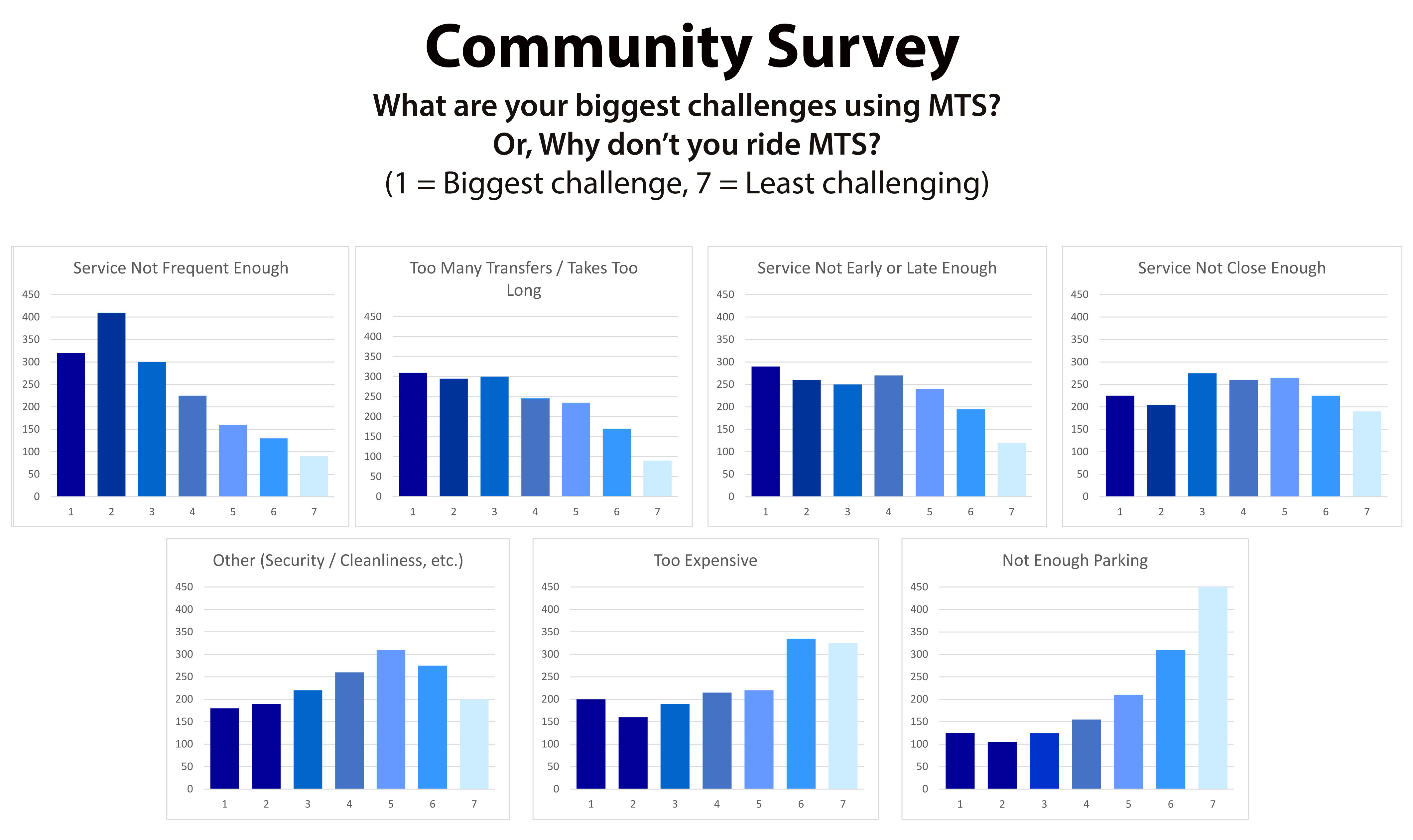
Faster buses bring new riders.
Getting riders to their destinations more quickly also attracts new riders.[10] This is key to both climate goals and the financial health of a transit agency. Alarmingly, transit ridership declined nationwide during the 2010s.[11] This decline can be attributed to higher rates of travel by car.[12] Such declines are often caused in part by rising housing costs near city centers, driving low-income residents farther away from jobs.[13] In MTS’s 2015 survey, non-transit riders identified time and convenience as their number one reason for not choosing transit.[14]
MTS ridership rose in 2019 after MTS implemented higher frequencies and increased speeds.[15] Since the initial decline in ridership caused by the COVID-19 pandemic, MTS ridership has rebounded more quickly than the ridership of many other transit agencies. MTS ridership is on pace to exceed pre-pandemic ridership this year.[16] MTS can continue this trend by implementing the recommendations in this report.
New riders are essential for climate goals. Transportation accounts for 50 percent of all local greenhouse gas emissions in San Diego, making it the largest single source of greenhouse gas emissions in the City.[17] In order to address this, the City of San Diego’s Climate Action Plan set a goal that 15 percent of all trips made will be on transit by 2035.[18] Improvements that make the bus run faster will also bring new riders, who in turn generate more money that can be put towards other improvements to service. The quickest route to climate and financial benefits is with a faster bus.
A faster system is a more equitable system.
Campaigns from transit advocates around the country agree that fast, reliable service is “a matter of racial justice and transit equity.”[19] The same holds true in San Diego: MTS riders are disproportionately people of color and disproportionately low-income.[20] Fast, reliable buses are critical to riders’ ability to access jobs, schools, and services.
In particular, access to jobs is critical for economic mobility. As city centers become more expensive places to live, poverty has concentrated in areas farther from jobs.[21] A 2015 study found that when children moved to neighborhoods with average commute times of less than 15 minutes, the move correlated with an average seven percent increase in income in adulthood.[22]
In San Diego County, only one percent of jobs are accessible by public transit within 30 minutes, and only eight percent are accessible in an hour.[23] This means that the 78 percent of transit riders who do not have a car are cut off from access to 90 percent of jobs in the County.[24] Making the bus run faster gives riders access to more and better jobs.
Bus riders with long commutes may have difficulty arriving at work or school on time. In addition, long commutes add stress and leave less time for homework, child-rearing, working, or enjoying life. Improving bus service tangibly improves the economic mobility and quality of life for some of our most vulnerable residents.
MTS Route 933
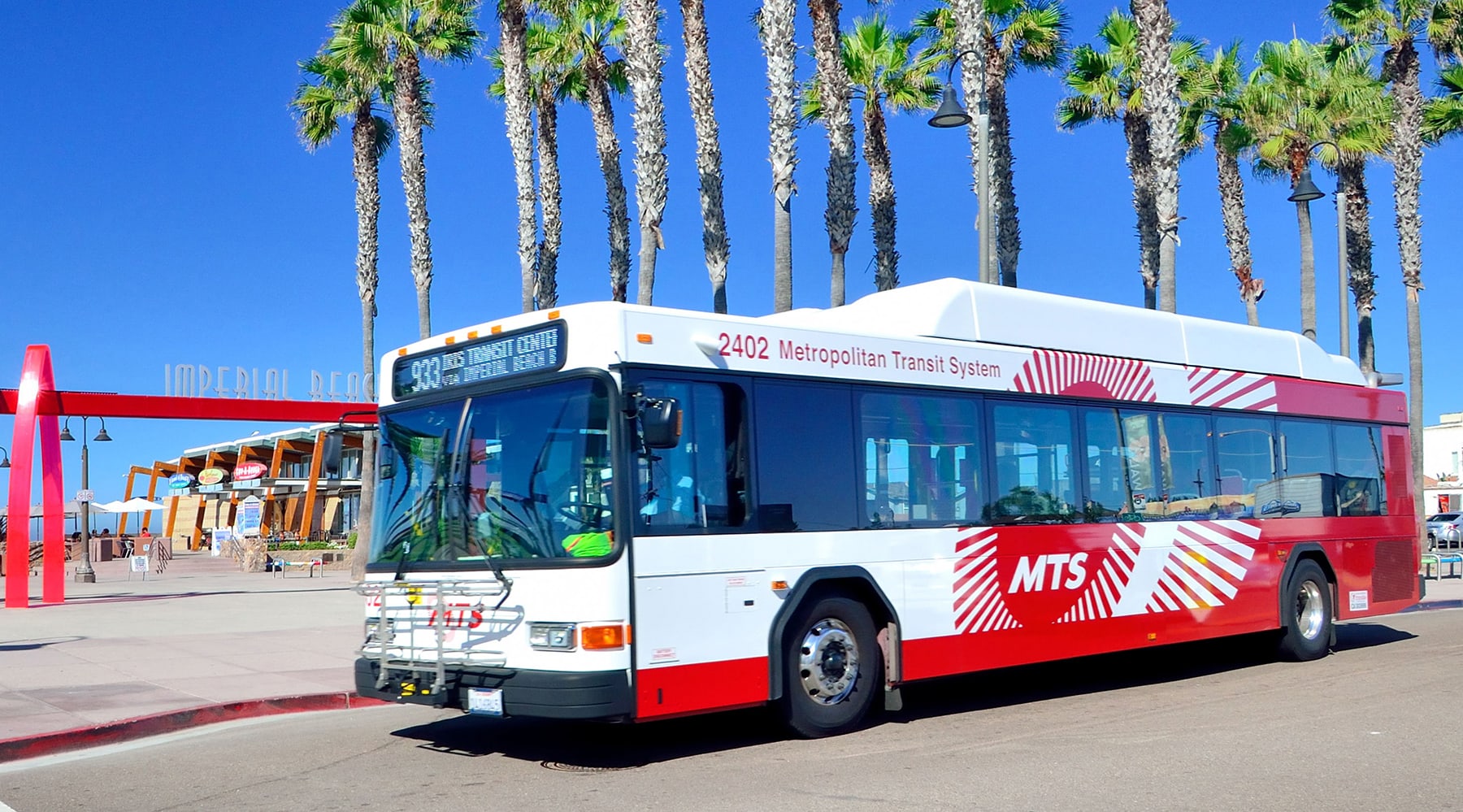
The Opportunity
Recent changes in San Diego’s transportation landscape provide an opportunity for MTS to make the bus go faster. The PRONTO card, which was introduced in 2021, already offers transit riders fare capping, free transfers, and improved interface with a smartphone app. It also offers an opportunity for faster fare collection systems.[25]
In 2019, MTS completed a Transit Optimization Plan, which increased frequencies across high performing routes, eliminated some stops, and improved reliability.[26] The plan resulted in increased ridership.[27]
SANDAG’s adopted 2021 Regional Plan identifies near-term funding for several bus rapid transit routes and frequency upgrades for more than two thirds of all bus routes by the end of 2025.[28] These upgrades have been identified for implementation sooner than in previous regional plans.[29] However, some funding for the Regional Plan was dependent on a 2022 ballot measure, which failed to qualify for the ballot.[30] SANDAG should prioritize bus frequency and capital upgrades over other elements of its plans in order to ensure fast, reliable service on the bus.
Furthermore, the 2021 Regional Plan identifies a variety of bus routes where improvements will occur but is generally not specific about the types of improvements, beyond frequency upgrades. The recommendations from this report, including bus-only lanes, signal priorities, among others, should be funded as a part of the improvements SANDAG intends to make. By making funding improvements to the streets, SANDAG can maximize the benefit to the investments it is making by funding increased bus frequency.
Understanding Bus Travel Time
Three factors impact the time it takes to get from origin to destination: speed, frequency, and dwell time.
Speed.
The most obvious factor in bus travel time is the speed at which the bus moves between stops. Increasing bus speed depends on allowing the bus to bypass local traffic. Improvements that increase bus speed include dedicated bus-only lanes, transit signal priority, and freeway bus priority lanes.
Frequency.
The frequency of a bus route is how often the bus comes. When a bus comes more frequently, rider wait times decrease. That decreases the time of the trip overall. Increasing bus frequency requires more vehicles and drivers in order to serve a route more often. It also may require more maintenance personnel and storage yards. Increased frequency can sometimes happen without additional vehicles and drivers when speed is increased and dwell time is reduced. If a route can be completed more quickly, it can be served more often by the same number of drivers.
Dwell time.
Dwell time is the period of time that a bus spends at stops or stations. This includes when riders board or alight, pay fares, and buses merge back into the travel lane. Dwell time can be approximately 10 to 25 percent of a typical bus journey.[31] Dwell time can be reduced through several strategies, including all-door boarding, off-board fare
collection, in-lane stops, and bus stop balancing. MTS has already implemented a tap-and-ride system that reduces the frequency of cash payments, which take longer.
Travel Time Improvements Increase Reliability
Issues with on-time performance and reliability are caused when transit agencies cannot accurately predict how long a bus route will take. Improvements that increase frequency and speed or lower dwell time result in increased reliability.[32]
When buses are stuck in traffic and when passengers take a long time to board, the amount of time a bus route takes can vary widely. By separating buses from traffic and reducing passenger loading time, buses are made more consistent and predictable.[33] This allows transit agencies to keep buses running on time. Moreover, when buses run more frequently, interruptions like bus breakdowns have less impact on riders because the next bus is not too far behind.
Park Boulevard dedicated bus-only lane
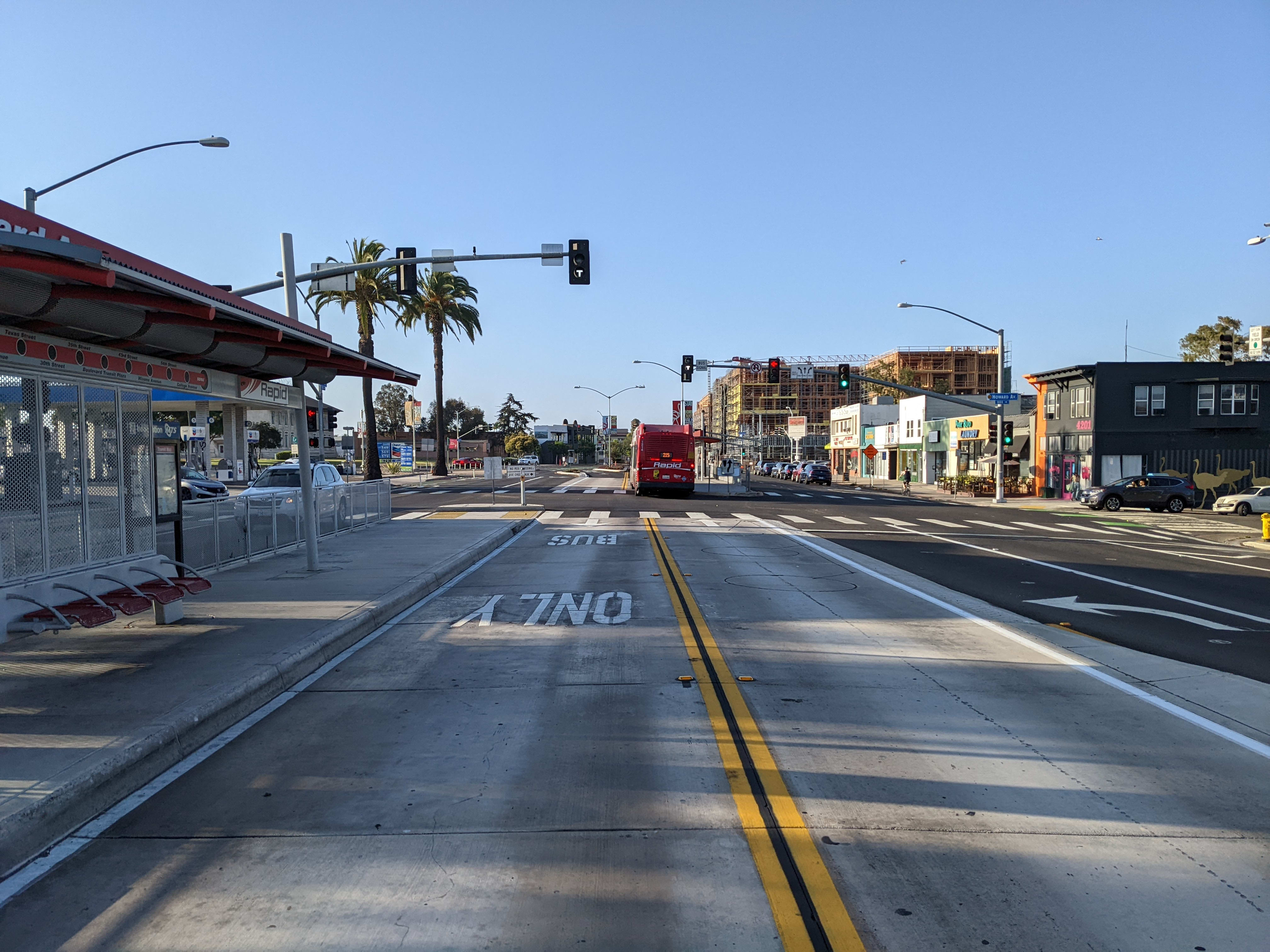
Recommendations
There are a variety of interventions that MTS, working with agency partners, can make to improve bus travel times. Many are cost-effective, especially when compared with larger capital construction, and could be implemented with existing revenues.
Many of these improvements also require participation and coordination with other agencies. Local governments control the design of streets, and their partnership and coordination is needed for improvements such as dedicated bus-only lanes. SANDAG is responsible for allocating funding and planning routes, so its participation is needed for decisions about funding increased service on priority routes.
Dedicated bus-only lanes.
When buses run in dedicated bus-only lanes, riders experience reduced travel times and buses have fewer collisions with other roadway users. This is because buses are not vying for space with other modes and conflict points are decreased. Transit agencies that implement basic dedicated bus-only lanes can deliver 25 percent faster commute times.[34] Dedicated bus-only lanes can include separate bus signals, which allows for easy transit signal priority.[35]
The ideal dedicated bus-only lane is a center-running lane with its own traffic signals, as was done on Park Boulevard. This kind of dedicated bus-only lane avoids right-turn conflicts and creates the best opportunity for transit signal priority. While the Park Boulevard lane is physically separated from traffic, dedicated bus-only lanes can also be implemented far more cheaply by installing only new painted pavement markings.
The two and a half mile long El Cajon Boulevard dedicated bus-only lane cost only $100,000 to implement.[36] Because the project included new pavement markings and avoided costly concrete work, the project was operational less than a year after it was included in the City of San Diego’s capital budget.[37] Dedicated bus-only lanes like this should be implemented where a solution is needed quickly and cheaply. They can also be implemented as an interim solution where a more robust dedicated bus-only lane is planned for the future.
Bus only-lanes, even with concrete work and new traffic signals, are far less expensive than new rail lines. If SANDAG continues to face funding shortages, this may be a desirable alternative to unachievable rail lines. Moreover, bus-only lanes can be converted to rail in the future.
Transit agencies lack full control over local roads, and therefore cannot implement dedicated bus-only lanes on their own. The El Cajon Boulevard dedicated bus-only lane is a good example of grassroots organizing and city leadership partnering with MTS to improve transit.[38]
Bus-only lanes often encounter resistance from some community members because they can appear empty even when operating as intended. This is because they move people more efficiently than a general purpose lane. A single general purpose travel lane can move between 600-1,600 people per hour while a dedicated bus-only lane can move between 4,000-8,000 people per hour.[39] Messaging and buy-in from political leaders is therefore important to a successful campaign for dedicated bus-only lanes.[40]
Freeway bus priority lanes.
Bus priority lanes on freeways offer similar benefits to bus-only lanes on surface streets but have different technical and jurisdictional considerations. Freeway bus priority lanes require coordination between SANDAG, Caltrans, and transit agencies to move forward. Like dedicated-bus only lanes on surface streets, freeway bus priority lanes can be implemented in multiple ways.
The Centerline, which opened in 2018, provides separated bus-only lanes along the I-15 between the I-8 and I-805 freeways.[41] The segment has two freeway-level stations, one at El Cajon Boulevard and one at University Avenue, and cost $65 million.[42] This allows the Rapid 235 to proceed unobstructed by traffic or by detours for stops that are off of the freeway.
Freeway bus-on-shoulder programs allow buses to run along the freeway shoulder when car traffic is congested. These programs can be implemented more quickly and inexpensively than capital projects like the Centerline. San Diego recently launched a bus-on-shoulder pilot program, which required coordination between SANDAG, MTS, and Caltrans.[43] The program includes technology to coordinate with freeway on-ramp signals to give buses priority.[44] California law only allows bus-on-shoulder programs as temporary pilots but legislation can be sought to allow them to operate permanently.
There are a number of different ways to prioritize the bus on freeways. SANDAG’s 2021 Regional Plan contemplates both adding new lanes that prioritize the bus as well as the conversion of some existing general purpose lanes. Bus priority is also possible on a policy spectrum. Options can include limiting travel only to the bus. Other options like HOT Lanes[45] or Managed Lanes can allow some car travel, usually for a fee, with the revenues helping to finance more transit service. Many of these policy options have merit so long as they keep as their guiding purpose speeding up the bus.
The Centerline
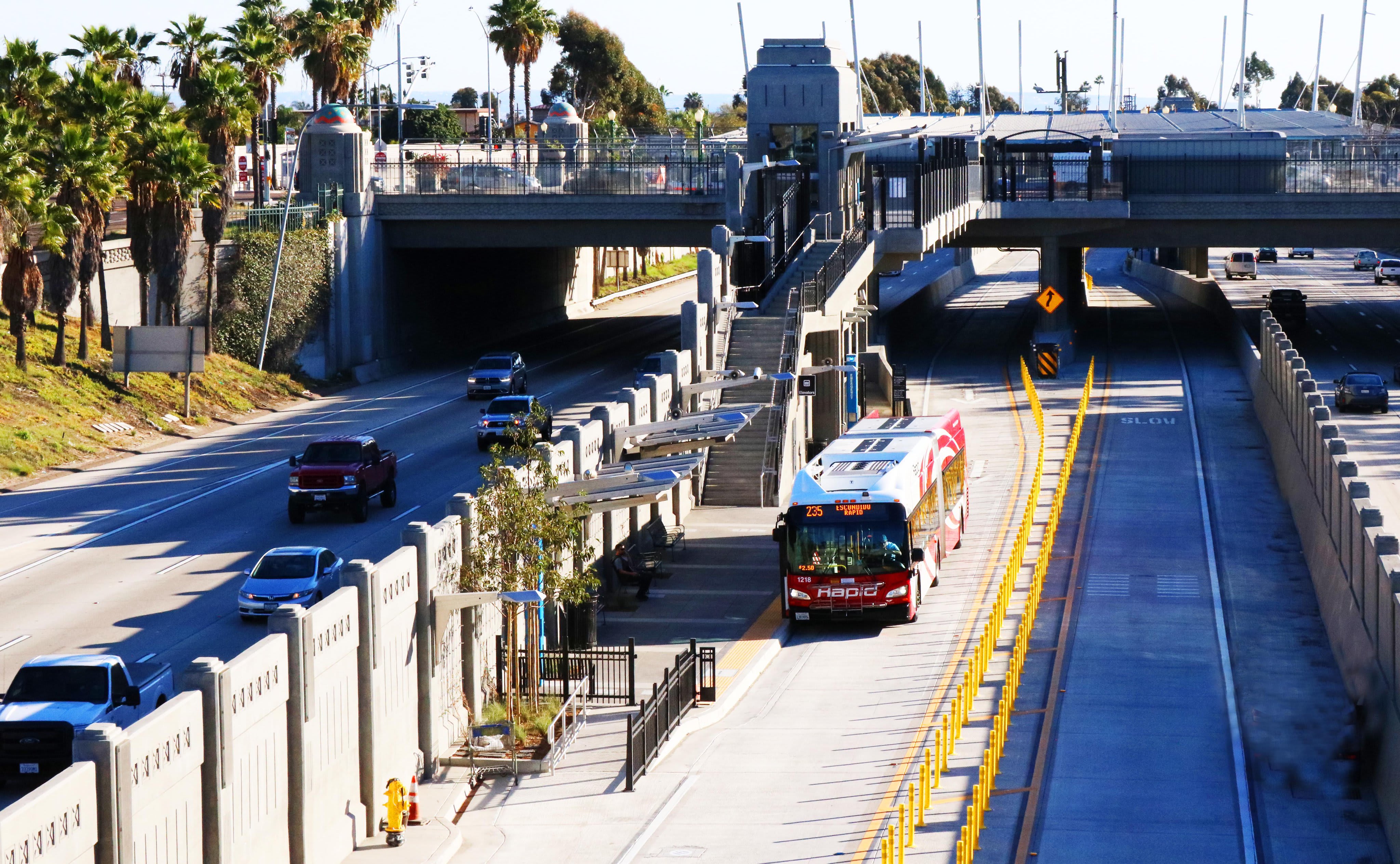
Automated enforcement of dedicated bus-only lanes and bus stop zones.
The recent adoption in California of Assembly Bill 917 allows transit agencies to use cameras mounted on bus windshields for automatic traffic enforcement.[46] The bill allows these programs to enforce dedicated bus-only lanes and “no-parking” zones near bus stops. Bus-only lanes that rely on street striping instead of physical separation have the benefit of being cheap to implement. However, painted lanes are vulnerable to scofflaw drivers utilizing the lanes, blocking bus travel.
Automated enforcement tools can help keep bus-only lanes clear and also keep operations costs by transit agencies lower. Reducing obstructions can reduce dwell times, enhance the safety of all-door boarding, make in-lane bus stops more effective, and generally improve accessibility. Successful pilots of automated bus enforcement have been conducted by both LA Metro and the Alameda-Contra Costa Transit District (AC Transit) utilizing technology from California-based Hayden AI.[47]
Bus stop balancing.
The distance between one bus stop and the next on a bus route is a tradeoff: the more stops, the closer riders are to their destinations. The fewer stops, the faster the trip overall.[48] Historically, many transit agencies have opted for stops that are very close together, often every block or two.[49] Agencies can reduce dwell time by reducing the number of stops.
Agencies outside San Diego have seen success with this approach. The San Francisco Municipal Transportation Authority’s bus balancing program reduced bus stops from six stops per mile to two and a half stops per mile, resulting in a four to 14 percent increase in bus speeds.[50] TriMet in Portland, Oregon saw five percent faster journey times by adding an average of 90 feet per stop on one of their busiest routes.[51]
MTS has already reduced the number of stops on several lines, many of which were done as part of their Transit Optimization Plan completed in 2019.[52] In 2019, MTS reduced the number of stops on Route 2 along 30th Street by 33 percent.[53] Before being balanced, there were 45 bus stops on Route 2 on 30th Street.[54] Many of these stops were only one-eighth of a mile apart, slowing travel times for most transit riders. Since the balancing, MTS has seen increased on-time performance on this route.[55] MTS should continue its progress of identifying areas where bus stops can be removed.
Removing bus stops can be problematic for riders who lose their closest bus stop. In order to ensure an equitable balance of bus stops, MTS should prioritize stops that are important for passengers with disabilities, such as those near senior and disability services centers.
Transit agencies face potential liability for placing stops in locations where riders will predictably face danger reaching the stop.[56] If stop placement is impaired by dangerous street conditions, cities should work with transit agencies to determine where bicycle and pedestrian improvements need to be made.
Moreover, transit agencies, cities, and SANDAG should pair bus upgrades with safe routes to transit planning efforts to ensure safe pedestrian and bicycle access to new and existing bus stops.
Bus stop balancing approach
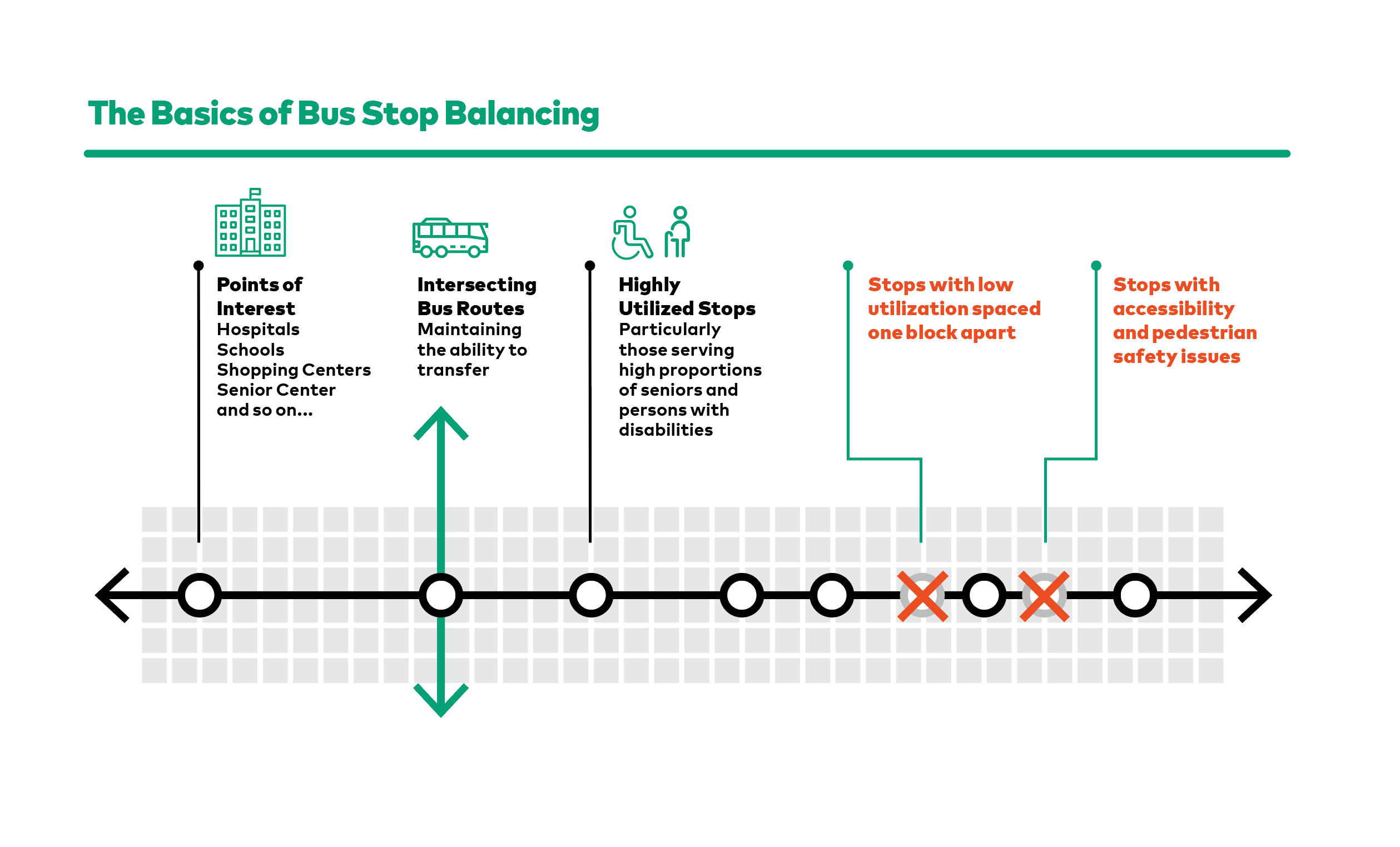
In-lane bus stops.
Many bus stops are located on the curb where the bus must move out of the lane of traffic. This results in delay when the bus attempts to merge back into the lane. By redesigning bus stops to be in-lane, dwell time can be reduced by between five and 20 seconds per stop. This time reduction is even greater as traffic congestion increases.[57]
Near-level bus boarding.
Level boarding is where the bus stop height is the same as the entrance of the bus. This is important to many older adults, those with mobility limitations, and people with strollers or shopping carts. Unfortunately,
extending a ramp or using a “kneeling bus” function to lower a bus’s height can significantly increase dwell time. When the curb is level with the bus, ramps or “kneeling” are not needed to serve passengers with limited mobility or with strollers.
Adapting the curb to provide an in-lane bus stop with near-level boarding can be achieved quickly and at relatively low cost with bus boarding pads. These pads can be designed to integrate with bike and pedestrian infrastructure, supporting a variety of modes on the streets. U.C. San Diego recently acquired three bus boarding pads at a total cost of $100,000, which will be deployed for Triton Transit, the university’s on-campus shuttle and bus system.[58]
A bus boarding pad with an integrated bike lane in Portland, Oregon
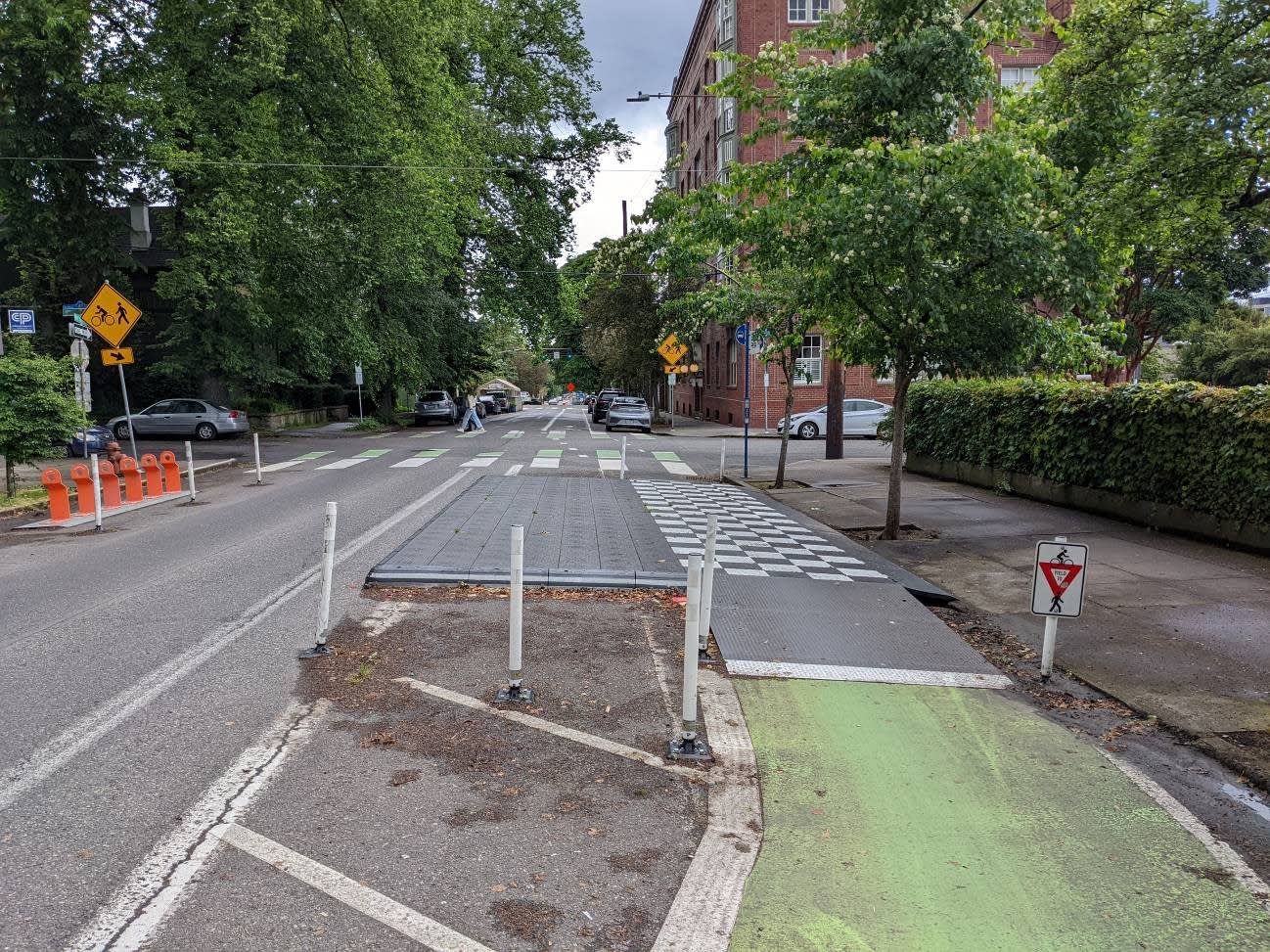
Transit signal priority.
Transit signal priority tools modify traffic signals for buses and emergency vehicles to reduce the time that a bus waits at red lights. Transit signal priority can reduce transit delays significantly.[59] In New York City, transit signal priority improved reliability and reduced travel time by 18 percent on affected routes.[60]
Traffic signals on the Park Boulevard dedicated bus-only lane
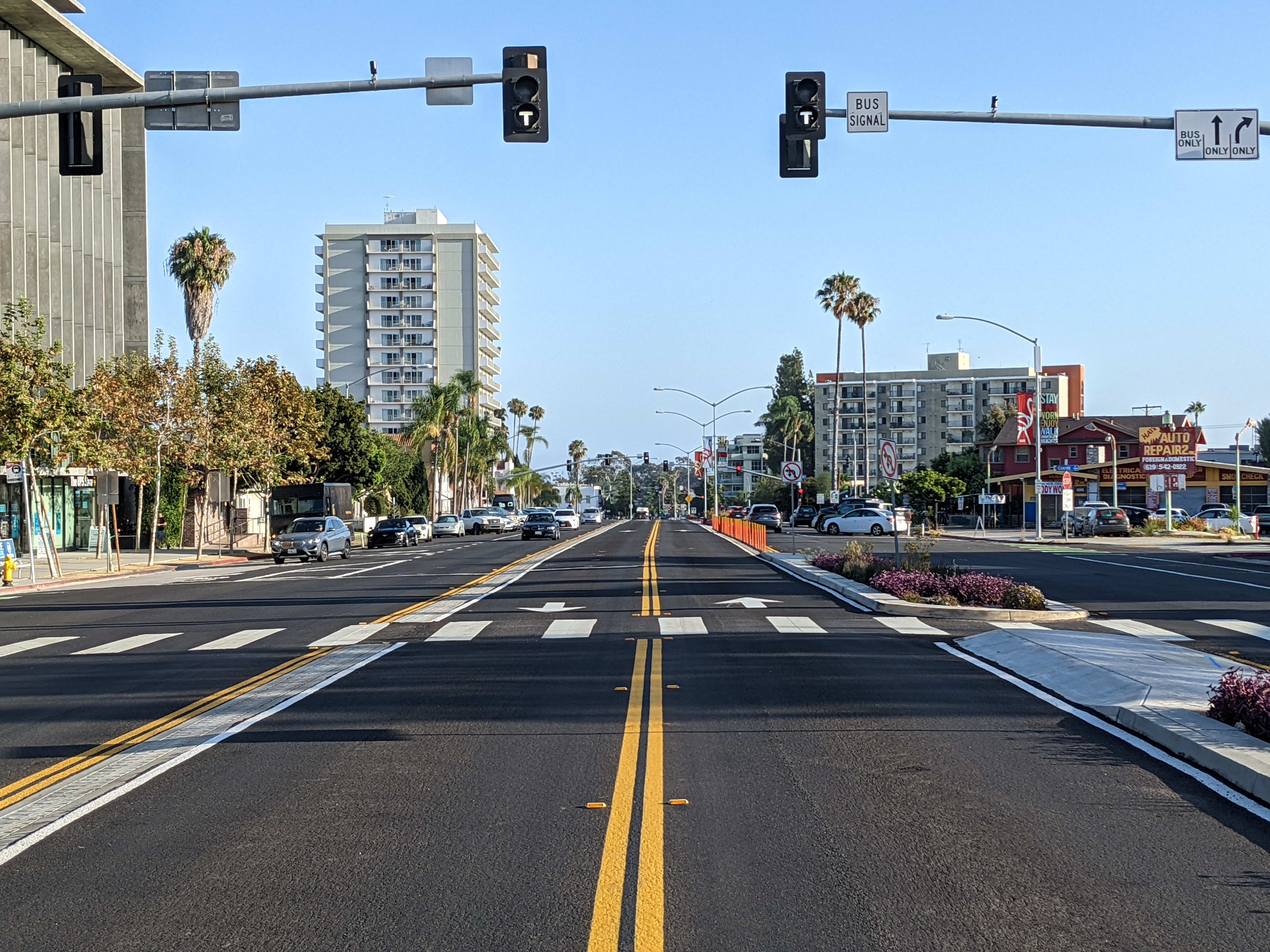
Improved frequencies.
Bus frequency is often overlooked but it has a tremendous impact on riders. High frequencies mean shorter wait times, reducing overall trip times.
When a bus route is low-frequency, riders are forced to time their day around when they can expect a bus to arrive. If a bus only comes once per hour, a rider must know when the bus is scheduled to arrive, make sure to arrive early, or wait a full hour for the next bus to arrive if they miss the one they had planned to take.
In contrast, on a high-frequency bus route, a rider can simply arrive when it suits
them and know that in a relatively short period of time a bus will arrive.[61] High-frequency service is generally considered to have headways of 15 minutes or less.
Frequency also makes transfers more effective. On a low-frequency bus route, riders who miss their transfer are forced to wait for long periods of time for the next bus. High-frequency routes mean that bus riders can simply wait a short time for the next bus to arrive if they miss a connection.[62]
Higher frequencies do result in higher operating costs but those costs are reduced when higher speeds are achieved. Higher frequencies on preferred corridors attract more riders, which can then improve revenues and farebox recovery rates that in turn support higher service levels.
Higher frequencies mean shorter trips and better access to jobs and other destinations. Increased frequencies can also generate good jobs directly, funding more bus drivers and maintenance workers with union wages and benefits.
Extended service hours.
Bus riders, and particularly essential workers, often work outside of traditional nine to five schedules. For these riders, it is important to be able to take a bus home late in the evening or early in the morning. In some cases, expanding service hours can increase ridership during the hours that were already covered.[63] This can happen where one part of a rider’s planned trip is during service hours but another part of the trip, such as the return trip, is not. When hours are extended, both trips are added to ridership.
Extended service hours are expensive because they require additional bus operator time. Transit agencies should pilot extended service hours on routes that are likely to see significant late night or early morning ridership. Those could be routes that serve employment areas with early or late shifts, including the NASSCO shipyards, San Diego International Airport, and in areas like Downtown with large service and tourism sectors.
Fare payments.
Fare collection and boarding can be time-consuming, accounting for half to a third of vehicle operating time.[64]
MTS and North County Transit District (NCTD) recently launched PRONTO, the new regional fare payment system.[65] San Diego now has a modern account-based fare system like other major cities across the country. Switching to PRONTO has already improved dwell time by giving riders a more convenient payment tool than the previous Compass Card system as it decreases cash payments. In Los Angeles, onboard smart card payment reduced dwell times by 10 to 35 percent compared to cash.[66]
Anecdotal experience suggests that transit riders using the QR codes on their phone’s PRONTO apps have trouble with reliability. Riders report having to scan their apps numerous times for the optical readers to process fare payment. Sometimes payment is never processed. That can extend payment times and delay transit service. MTS should evaluate the impact and effectiveness of the new system. They should be concerned both with the impact to transit travel times, as well as the impact of reliability to fare collection rates.
MTS has made significant efforts to ensure access to the PRONTO system, distributing over 120,000 PRONTO cards and ensuring availability at retail outlets and ticketing machines.[67]
MTS should implement family-friendly payment structures. Although children under 18 can currently ride for free, they still need to have their own PRONTO cards or app, which have to be converted online, over the phone, or in person at the MTS store or an NCTD Customer Service Center.[68]
Occasional youth transit riders are unlikely to have a validated PRONTO card. Giving parents and guardians the ability to include children on their PRONTO card or phone app would allow families more flexibility and decrease family boarding time.
Off-board fare validation.
Even though validating fares with PRONTO can be quicker than paying with cash, it still has a significant impact on dwell time. For the busiest stations and stops, MTS should install platform validators and ticket vending machines identical to the ones at existing trolley stations to reduce loading time. Passengers can validate their fares before boarding the bus, shortening dwell time.
Fares can be policed with random onboard fare-checks as they are on the trolley. Some fare evasion is inevitable; however, MTS should prioritize increasing the speed of routes and increasing ridership over achieving zero fare evasion. Off-board fare collection can significantly reduce passenger boarding times with dwell time per passenger falling from about four seconds to two seconds.[69]
An off-board fare validator at a rail station
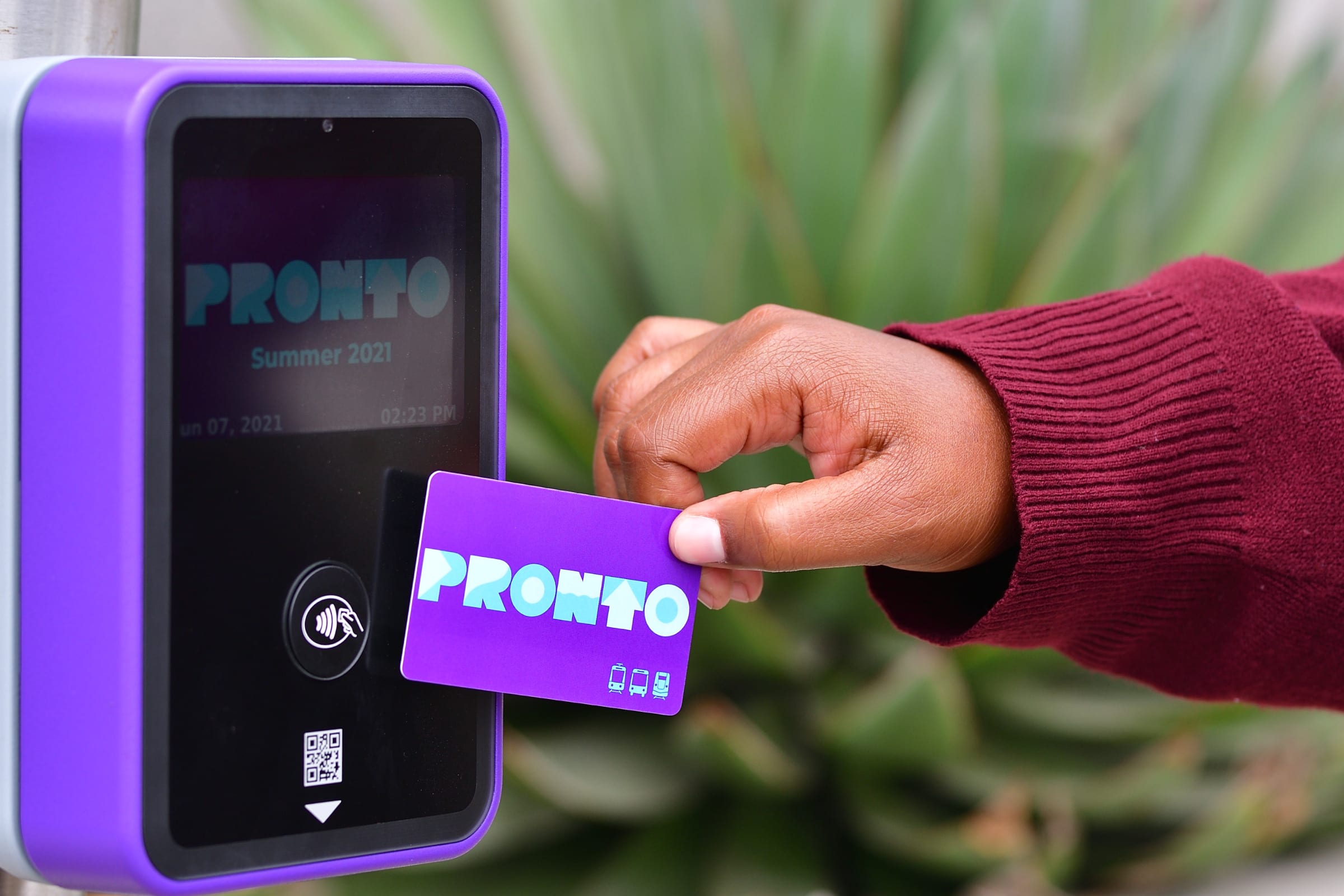
All-door boarding.
All-door boarding allows passengers to board at any door. This requires off-board fare validation or additional fare validators to be installed inside bus rear entrances. San Francisco Municipal Transportation Authority implemented systemwide all-door boarding and saw Muni bus travel speeds increase an average of two percent. It also reduced per passenger boarding time by 38 percent.[70] The change resulted in lowered variability in dwell time, making service more reliable and predictable.[71]
Notably, all-door boarding allows able-bodied riders to board while riders with limited mobility or with strollers can use the ramp at the front of the bus, which can also contribute to faster boarding overall.
All-door boarding in San Francisco
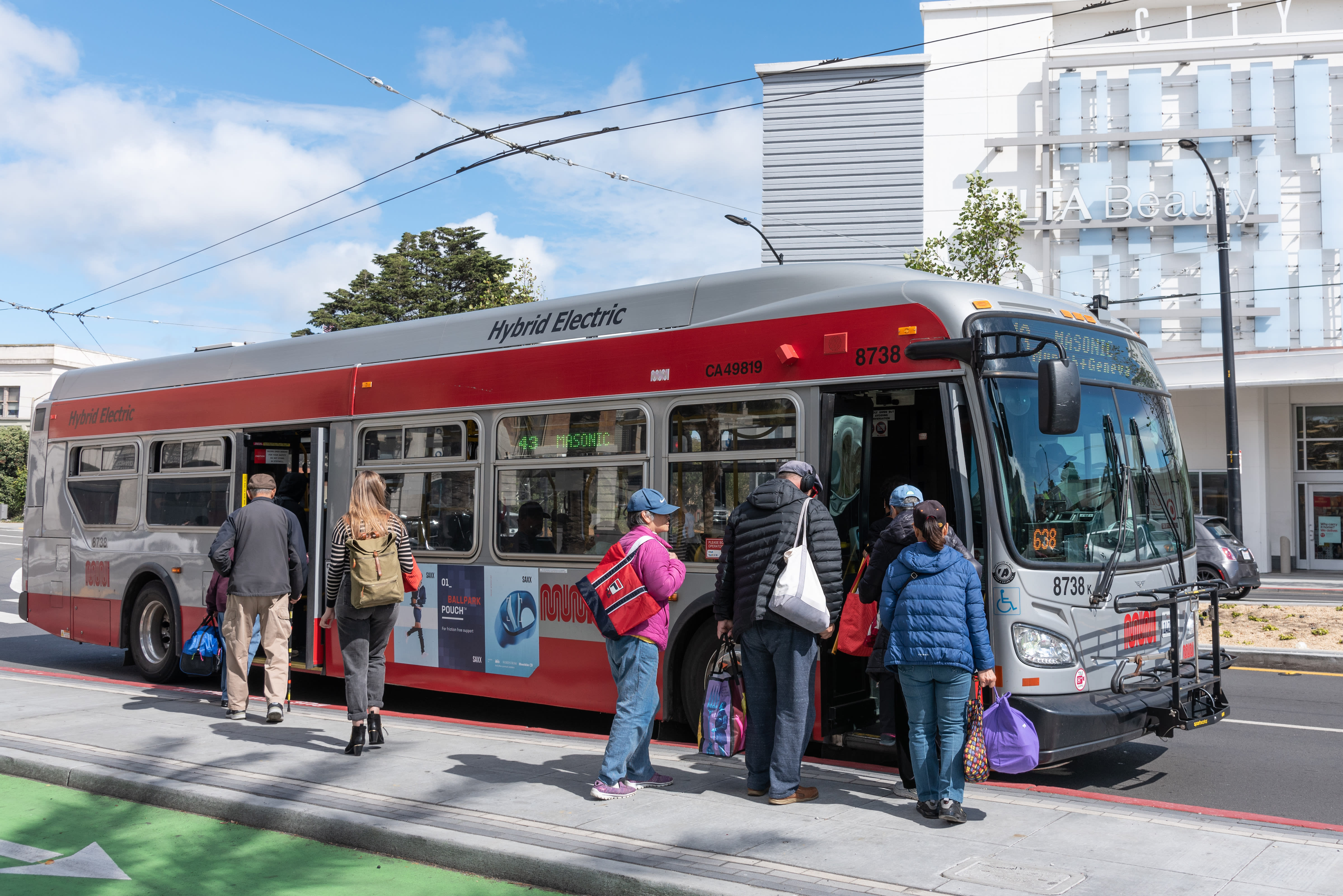
Specific Opportunities
SANDAG’s adopted 2021 Regional Plan includes funding for “Rapid” bus transit projects with “light” versions of some of the projects to be completed by 2025.[72] MTS routes phased for completion by 2025 include Rapid 10, Rapid 12, and Rapid 292.[73] NCTD 450 is also phased for completion by 2025. Rapid 10 and 12 are Rapid versions of existing bus routes and Rapid 292 and 450 will be new routes.
Funding already exists for these Rapid routes, but no detailed plans exist. SANDAG should implement the recommendations of this report when implementing these first Rapid routes.
Given that funding is for “light” versions of Rapid and may not be enough for significant capital construction, SANDAG should prioritize cost-efficient methods of delivering better service, such as painted bus-only lanes and bus boarding pads. These routes are also opportunities for SANDAG to pilot off-board fare validation and all-door boarding.
The 2021 Regional Plan includes funding for capital improvements for over 20 Rapid routes by 2035.[74] This should be spent to implement the recommendations of this report, to minimize travel time and maximize ridership.
Although it is not currently funded for any capital improvements, Rapid routes 201 and 202 – The SuperLoop – are excellent candidates for piloting some of these recommendations. These lines serve the U.C. San Diego campus and have exceptionally high ridership. Unfortunately, they are often delayed as large numbers of students attempt to get on and off the bus.
This route features long, three-door articulated buses. Anecdotally, riders boarding at the front door do not always continue to the back to make room for boarding riders. This can lead to buses leaving would-be riders at the station because the bus appears full.
The specific circumstances of these routes make them good candidates to pilot all-door boarding and off-board fare validation. Both treatments would specifically address challenges faced by these lines. Additionally, U.C. San Diego student riders are good candidates for an improved bus line because they already have free access to the bus with their student identification cards and are tech savvy enough to navigate changes to the system. A successful collaboration between MTS, SANDAG, U.C. San Diego, and the City of San Diego could be a demonstration project for system-wide application of these strategies.
Conclusion
Creating a fast bus network requires coordination between cities, which control local streets, SANDAG, which controls capital and service funding, and transit agencies, which operate service. By implementing the recommendations of this report, government agencies can achieve faster, more frequent, and more reliable bus service.
While the benefits of any of these individual changes can be small when combined they can significantly reduce journey times. For example, in New York City, the Metropolitan Transit Authority implemented transit signal priority, all-door boarding, and dedicated bus-only lanes and saw a 15 percent increase in ridership on weekdays.
These changes can be implemented with relatively low costs compared to other types of infrastructure. We can increase bus ridership and achieve our equity and climate goals by delivering to the San Diego region a fast bus!
Acknowledgements

Jesse is policy counsel for Circulate San Diego, where he researches and advocates for policy solutions to create a more affordable and sustainable San Diego.

Sean Walcott is a transportation professional, with experience working for transportation technology firms. He is a candidate for a Masters of Business Administration from the University of San Diego.

Colin Parent is executive director and general counsel at Circulate San Diego. He has authored a number of reports and academic publications detailing how local land use and transportation policy can be improved to advance equity, promote economic development, and to address climate change. Colin is also an elected Councilmember of the City of La Mesa, California.
About Circulate San Diego

Circulate San Diego is a nonprofit whose mission is to create excellent mobility choices and vibrant, healthy neighborhoods. Circulate promotes public transit, safe streets, and sustainable growth. Circulate has successfully led campaigns to transform empty parking lots into affordable homes, to implement free transfers for transit riders, and for local jurisdictions to adopt Vision Zero to end traffic fatalities and serious injuries. For more information, visit www.circulatesd.org.
Special Thanks
This report is unabashedly inspired by the many reports published by TransitCenter on how to improve bus service. Thanks to the staff at the San Diego Metropolitan Transit System, the San Diego Association of Governments, and the City of San Diego’s Planning Department for sharing information, advice, and their time to inform this report. Circulate staff and interns participated in the conception, editing, and drafting of the report, including Dara Braitman and Octavio Garcia. Thanks to Circulate’s legal intern Gianna Ceccarelli for legal research assistance.
The content of this report was informed by the expertise and feedback from an advisory committee, who we thank for their assistance. The advisory committee included Clint Daniels, Pedro Orso-Delgado, Clarissa Falcon, David Dekozan, Josh Kavanagh, Rachel Gregg, Silvia Croft, Debbie Richeson, Brandon Long, Mathew Vasilakis, David Bragdon, Eli Lipmen, Rabi Abonour, Randy Torres-Van Vleck, Satomi Rash-Zeigler, Delfina Gonzalez, Rick Bates, Tom Colthurst, and Alex Wenzel.
Sponsors
We are grateful for the financial support from our sponsors.



